These tips on visiting Knossos Palace in Crete will help you make the most of your time at Knossos Archaeological site just outside of Heraklion.
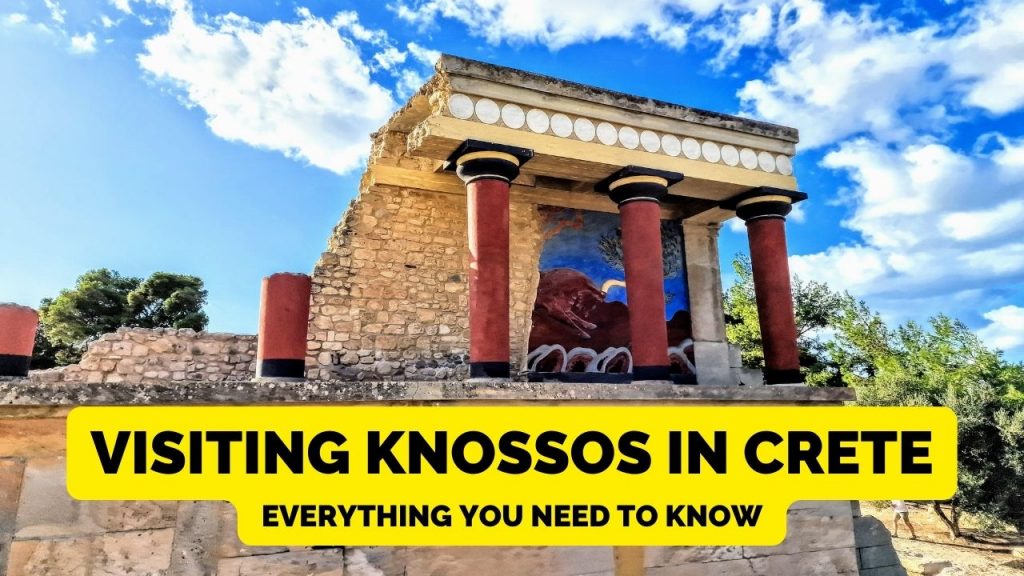
Minoan Palace Of Knossos Archaeological Site
Knossos was once the beating heart of the mysterious Minoan civilization on the Greek island of Crete. If the mythology is true, Knossos was also the home of King Minos, the Labyrinth and the Minotaur!
The largest and most prominent of the Minoan palaces, Knossos flourished during the Bronze Age, particularly around 2000-1350 BCE. The decline of Knossos and the ancient Minoan civilization is believed to have been influenced by natural disasters, including earthquakes and volcanic eruptions, as well as possible invasions from outside forces.
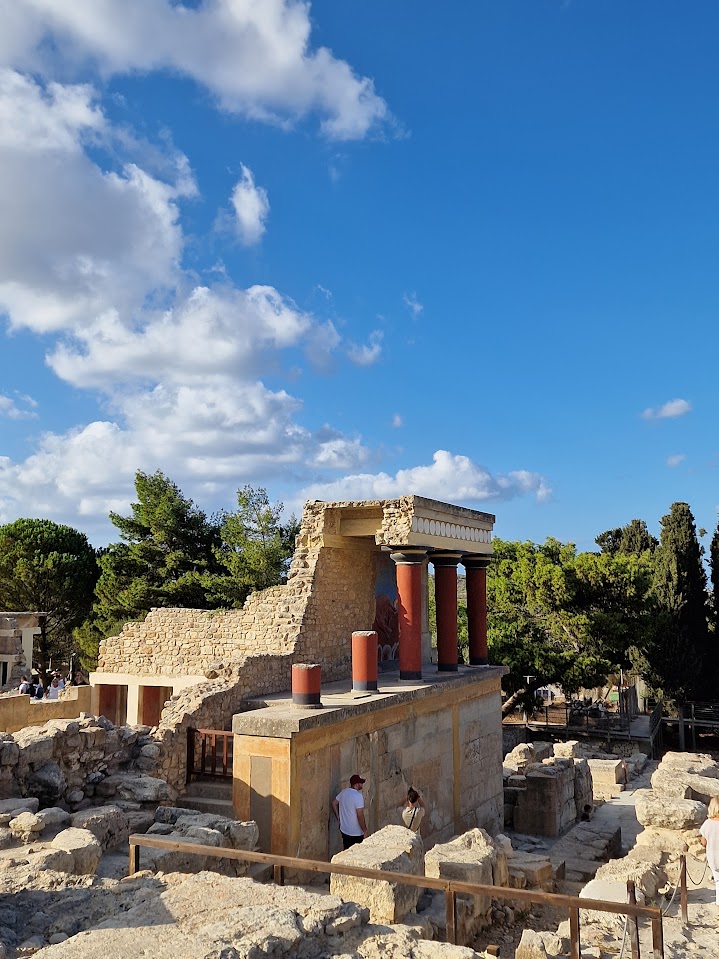
Nowadays, Knossos is an archaeological site open to the public, and one of the most popular places to visit in Crete. In fact, Knossos is the 2nd most visited historic site in Greece!
If you are planning to see Knossos palace during your time in Crete, this travel guide is an essential read. I’ve visited Knossos perhaps half a dozen times now during my various trips to Crete, and have put all the information I think you need to know in order for your Knossos visit to go smoother.
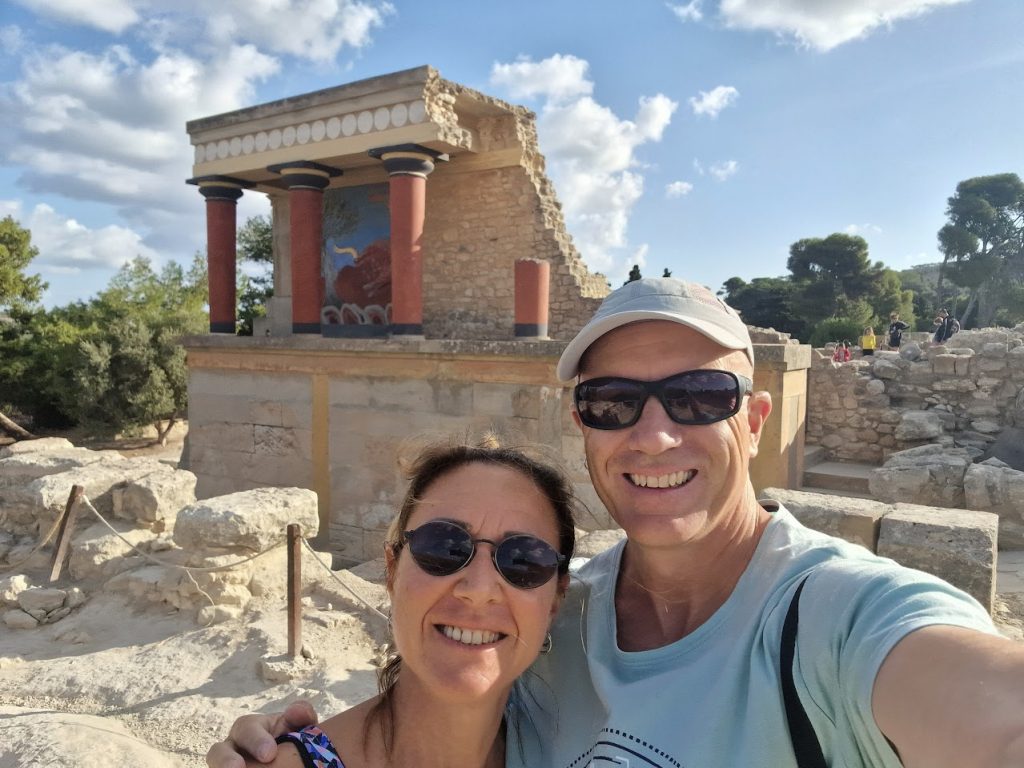
2024 Update: Up until now, you have been able to buy a combined ticket for both Knossos Palace and the Archaeological Museum of Heraklion. From April 1st 2024, this may no longer be available as ticket prices for ancient sites in Greece were recalculated and most combined tickets discontinued.
How To Get To Knossos Palace From Heraklion
The Palace of Knossos, Crete is located about 5.6 kms from the center of Heraklion Old Town. You can see it on the map here: Knossos Ancient Site
Despite the relatively short distance, it will take at least 20 minutes to get there from the center of Heraklion no matter which way you choose to travel to Knossos due to the traffic.
Taxi: The quickest way to get from Heraklion to Knossos is by taxi. It’s also the more expensive, and a taxi ride from Heraklion center to Knossos will cost 14-20 Euros.
Driving: If you’ve rented a car in Crete, you’ll be pleased to know there is a large parking lot just outside the site of Knossos where you can leave your car. Google maps works fine as a navigation tool to get you there. (Also read: Do you need to rent a car in Heraklion).
Public Bus: This is the slowest way of getting from Heraklion to Knossos. The bus is the route 2 bus, although confusingly, the bus itself may have a number 20 on it. See photo below!

Hop On Hop Off Bus: All the various Hop On bus companies in Heraklion include stops at Knossos on their routes. You can buy a ticket here: Heraklion Hop On Bus
Walking: I don’t recommend walking to Knossos from Heraklion as it’s a long, pointless hike out and back along a quite boring road. Take the bus instead.
Knossos Guided Tours | Day Trips
I would say that most people arrive at Knossos as part of an organized tour. These run out of Heraklion as well as other main cities like Rethymnon and Chania. If you take a guided tour to Knossos, I’d suggest getting one which includes a stop at the excellent Archaeological Museum in Heraklion as well.
Note: Most guided tours in Greece do not include the entrance fee to the ancient sites, so you may have to factor in paying extra for this.
Here's some good tours that visit the Palace of Knossos and the Archaeological Museum of Heraklion:
- From Chania: Knossos Palace & Heraklion Full-Day Tour
- From Rethymno: Full-Day Knossos and Heraklion Tour
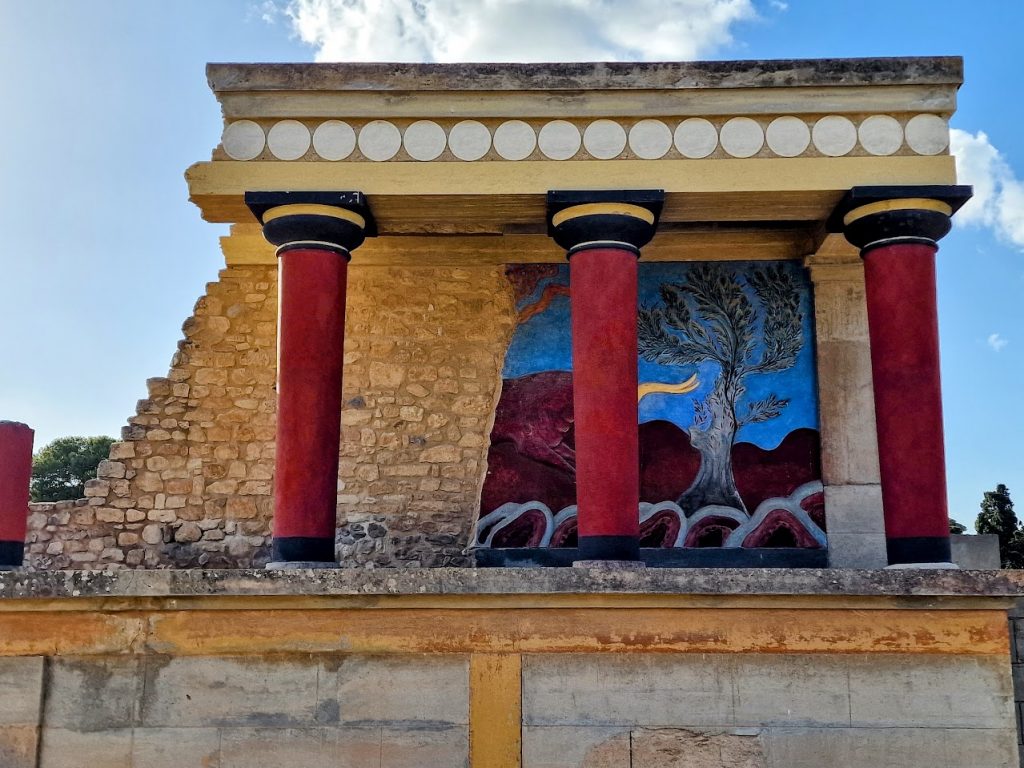
Best Time To Visit Knossos
The best time to visit the Palace of Knossos in Crete is either early in the morning or late in the afternoon. Visiting early helps avoid the crowds and the heat, while a late afternoon visit should be planned at least 2 hours before closing.
My key tip to visit Knossos, is to go early. The tour buses tend to arrive at around 9.00 am, so if you can get there before then, you will have an hour of peace. The second best option is to go later on, when the tours have all left.
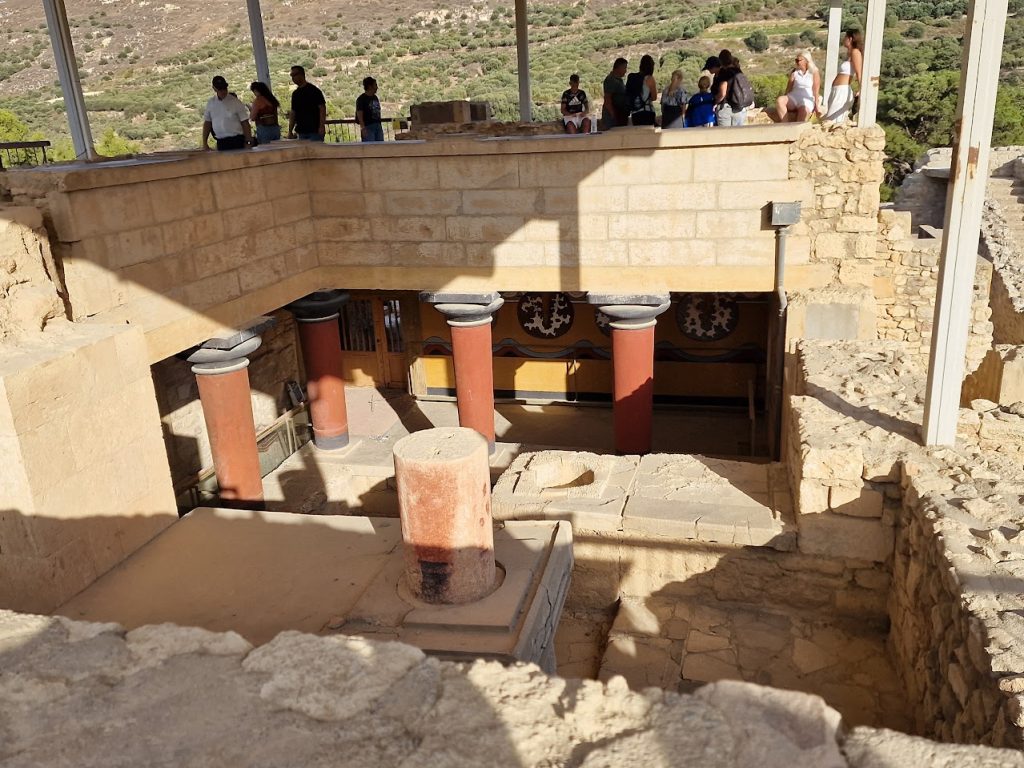
Actually, my real main advice is to visit out of season if you can travel whenever you want to. Most of the photos of Knossos on this page were taken in October when there are far fewer visitors to Crete.
Knossos Palace Opening Hours
Below is the most recent information for the Knossos Palace hours of opening. Things can and do change though. If in doubt, ask at your hotel before planning your day!
Please note that opening hours may change, so it's advisable to inquire at your hotel before planning your visit.
1st April to 31st August:
- Daily: 08:00 AM – 08:00 PM
From 1st September:
- Daily: 08:00 AM – 07:30 PM (Last admission at 07:15 PM)
From 16th September:
- Daily: 08:00 AM – 07:00 PM (Last admission at 06:45 PM)
From 1st October:
- Daily: 08:00 AM – 06:30 PM (Last admission at 06:15 PM)
From 16th October:
- Daily: 08:00 AM – 06:00 PM (Last admission at 05:45 PM)
Easter Hours (Greek Easter):
- Good Friday: 12:00 PM – 05:00 PM
- Holy Saturday: 08:00 AM – 04:00 PM
Free Admittance Days at Knossos:
- 6 March (in memory of Melina Mercouri)
- 18 April (International Monuments Day)
- 18 May (International Museums Day)
- The last weekend of September annually (European Heritage Days)
- 28 October
- Every first Sunday from November 1st to March 31st
Knossos Palace Closure Dates:
- 1 January: Closed
- 25 March: Closed
- 1 May: Closed
- Easter Sunday: Closed
- 25 December: Closed
- 26 December: Closed
Knossos Tickets
On my last visit, Knossos palace tickets cost 15 Euros for regular entry. At the time, there was also a combined ticket price for Knossos which included entrance to the Heraklion Archaeological Museum as well for 20 Euros.
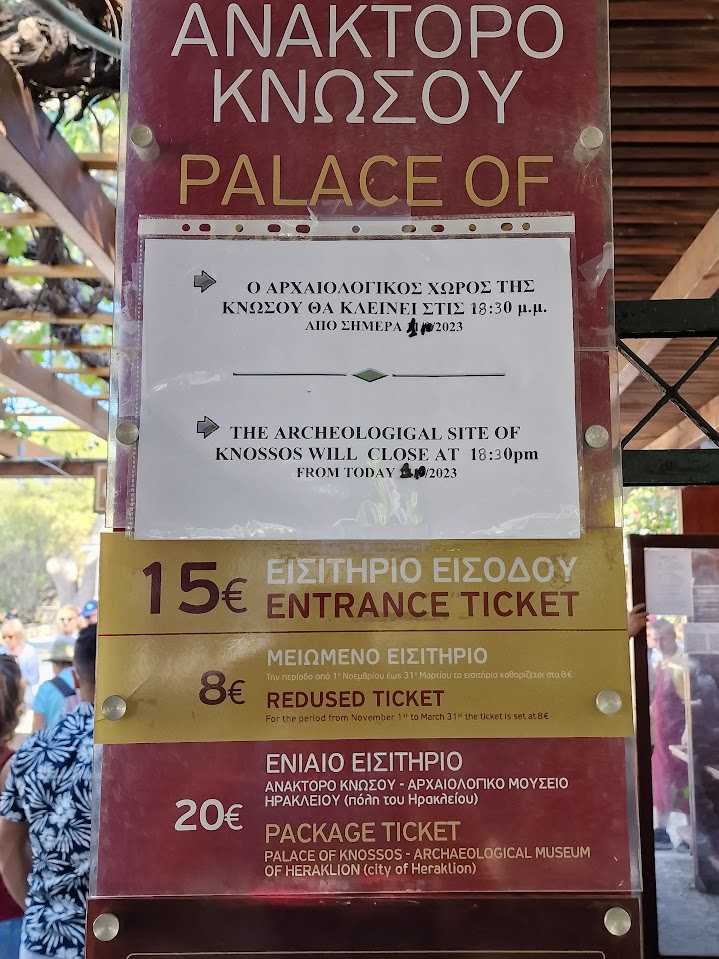
There has recently been some proposed law changes in Greece to ticket prices, and Knossos is set to lose its combined ticket from the 1st of April onward. This means you will need to buy a separate ticket for Knossos and the Heraklion Archaeological museum for the summer of 2024. No word yet as to if the individual ticket prices for each place will rise as well – let’s hope not!
Due to the popularity of the ancient ruins of Knossos, (it is the 2nd most visited site in Greece after the Acropolis in Athens, and ahead of Lindos in Corfu), you can expect queues at the ticket office.
In the summer, you may be able to use machines just outside the site of Knossos to buy an entrance ticket to avoid the queue. Unlike the Acropolis, you don’t need to pre-book a timeslot for Knossos – yet!
Entering Knossos Site
Once you have bought your ticket to Knossos, and have walked through the barrier, you may notice some official licensed guides waiting on the inside of the site offering tours. Typically, it is 10-15 Euros per person, and they gather a small group of 8-10 people together before beginning the tour.
You don’t necessarily need a guide tour of Knossos, but if you feel like it on the day, why not! Also in the entrance area, you will see a small cafe and toilets.

Knossos Digital Guide (Free!)
When I was last there, you could also see download links for a digital app which acts as a digital guided tour of the Palace of Knossos. If you are reading this on a laptop, you should be able to scan the QR code with your phone from the photo below and it will take you through to where to download the app.
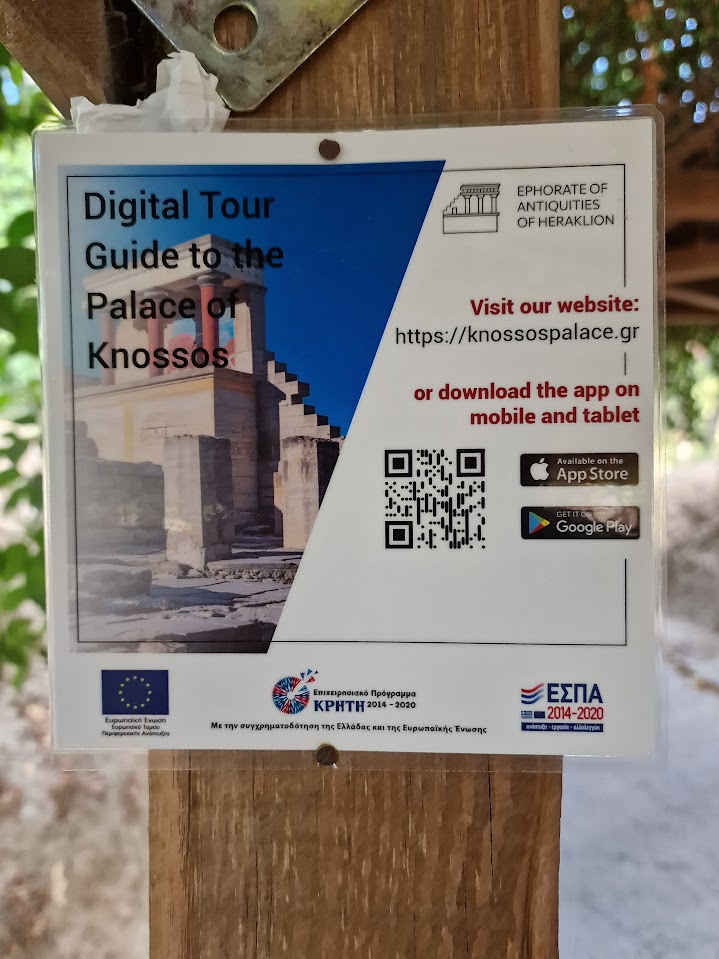
This is an official Knossos digital guide and totally free, provided with additional funding from the EU. The app is not super-intuitive, but give it a couple of minutes, as it has a lot of very useful information for visiting the Palace of Knossos.
If you don’t want to install an app on your phone, there is an online version of the Knossos digital tour here.
Walking around the ancient city of Knossos
There is more or less a one way system to walk around the site of Knossos, although you can easily backtrack if you think you missed an area, or want to return to get better photos of sights with fewer people in them.
As you explore Knossos, you will find some information boards in front of places of interest. I first visited Knossos about 40 years ago, and I’m pretty sure that these boards are the same from back then!
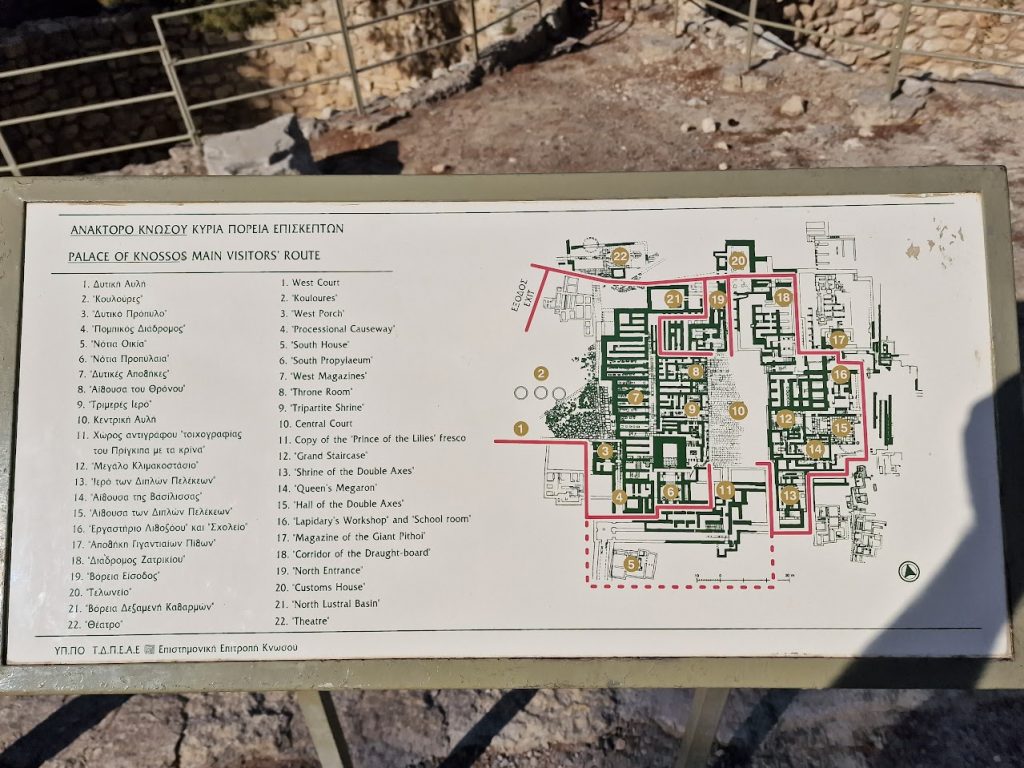
If you haven’t taken a walking tour around Knossos, these information boards along with the digital guide or a guide book will give you all the information you need about Knossos, the Minoan civilisation, and its fascinating history.
Sir Arthur Evans and Knossos Reconstruction Controversy
Sir Arthur Evans, the British archaeologist who led the discovery, excavation, and reconstruction of the Palace of Knossos, is at the center of a controversy regarding the reconstruction work he carried out at the site.
Evans' restorations are considered important for preserving and restoring much of Knossos, but they are also very contentious and, in some cases, damaging.
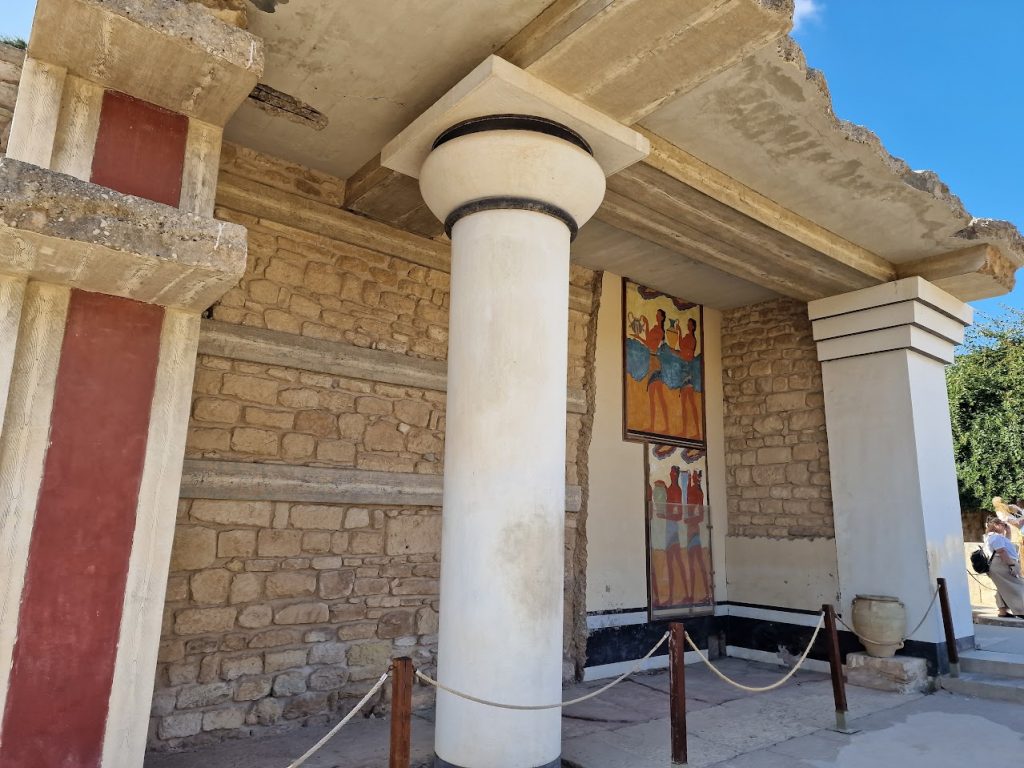
Critics argue that some of Evans' interpretations of the Minoan civilization were influenced by his personal beliefs and cultural biases of his time. Some of the techniques applied at that time, such as using wax and other substances to preserve frescoes, have since been considered inappropriate and potentially causing long-term damage to the artifacts. Evans' decision to restore the Bronze Age palace using modern building materials like concrete is also controversial.
This leads to the interesting question – what are we actually looking at in Knossos? Many of the important finds including wall paintings are in the archaeological museum of Heraklion. There is no real evidence the palace ever looked like the reconstruction or was coloured in the same way, and we can only really infer what Minoan culture was like.
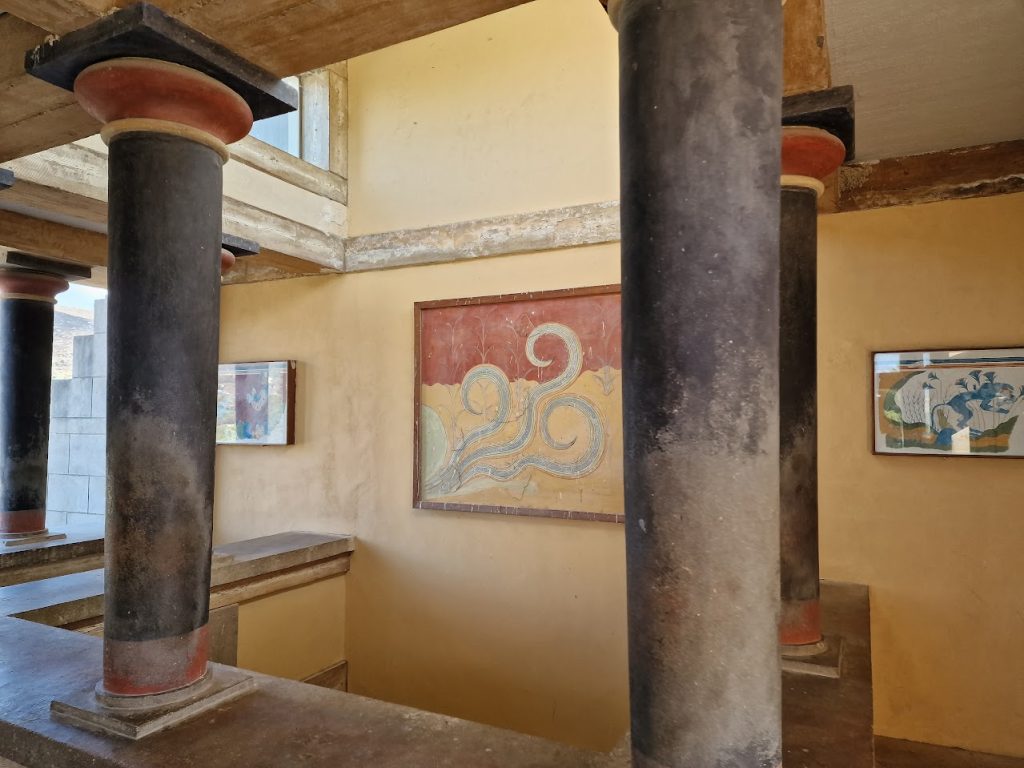
Labyrinth and legendary minotaur
The legendary Labyrinth, which housed the Minotaur in Greek mythology, is traditionally associated with the Palace of Knossos. It’s easy to see why, as I am sure in its heyday, it would have been easy to get lost wandering around the streets and alleyways of the Royal Residence.
Certainly the site of Knossos is strongly associated with several key symbols you could link to the myth, such as bulls and double-headed axes. Was there really a Minotaur though?
I personally found the link between Knossos and Bulls to be quite curious. It reminded me a lot of some Hindu temples in India, and some people draw links with Bulls in mythology and The Age of Taurus.
I also think the people of ancient Knossos might have had a festival similar to the Running of the Bulls in Pamplona, Spain. One of the famous Knossos frescoes – the bull leaping fresco – might back my theory up.
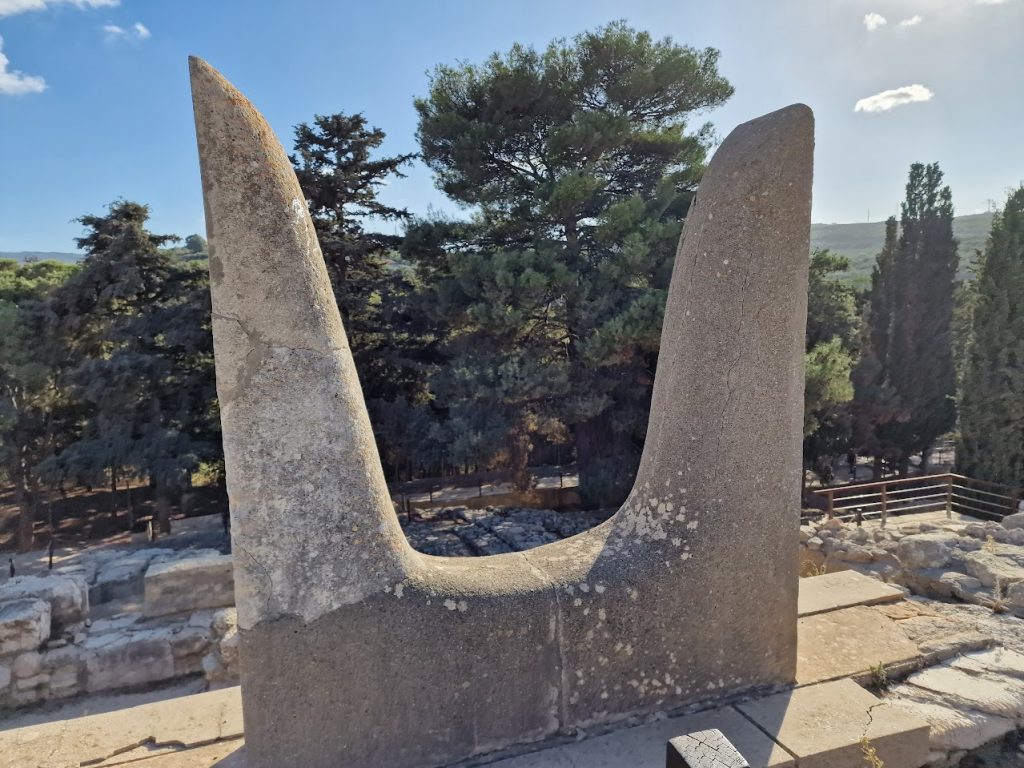
Minotaur and the Maze Myth
The myth tells the story of the Minotaur, a creature with the head of a bull and the body of a man, being imprisoned in a complex maze at Knossos. It also involves the Athenian hero Theseus who makes a journey to the island of Crete, and eventually slays the mythical Minotaur with the help of the legendary King Minos' daughter, Ariadne, and her ball of thread, which he used to find his way out of the Labyrinth.
The association of the Labyrinth with the Palace of Knossos is a subject of both myth and archaeological interpretation. While the archaeological evidence does not conclusively prove the existence of a physical maze-like structure at the site, the myth and the historical significance of Knossos have been intertwined for centuries.
How To Visit Knossos Palace FAQ
Readers planning a trip to the palace of Knossos often ask questions such as:
How much time do you need in Knossos?
To visit Knossos, it is recommended to spend at least 2 hours at the site. The best time to visit is either early in the morning or late in the afternoon to avoid the crowds and the heat
Is Knossos Palace worth visiting?
The Palace of Knossos is considered a must-visit for anyone interested in history and archaeology. It is the largest Minoan palace complex on the island of Crete and is permeated with legends, myths, and different historical facts.
How much does it cost to go to Knossos Palace?
The entrance fee for Knossos is 15€, and tickets cannot be purchased online although there may be some ticket sales machines operating just outside the entrance. From the 1st of April 2024, a combined ticket for Knossos and Heraklion Archeological museum will no longer be available.
Do you need to book the palace at Knossos?
Booking the Place of Knossos is not necessary, although there may be some queues for tickets in the busy summer season. Any skip the line tickets for Knossos you see online are sold by third-parties with a mark-up and are not from an official website.
Where was the home of the Minotaur in Crete?
The legendary Minotaur was said to be imprisoned in the Labyrinth, which is traditionally associated with the Palace of Knossos, located just outside of Heraklion which is the modern capital of Crete.
More Articles About Crete
Crete is the largest Greek island with a fascinating history and lots to see and do.
- As well as visiting the Palace in Knossos, you might also like to choose some of these other things to do in Crete.
- If you are based in Heraklion, these day trips from Heraklion are a great way to see Crete.
- If you are planning to spend longer on the island, why not try a road trip around Crete?
- Arriving by air to Crete? Here's my guide to transfers from Heraklion airport.
- Where is Crete?
- Best time to visit Crete
- Crete in October for autumn sun
- Athens to Crete All Possible Ways
- Athens to Crete (Chania) by ferry
- Is Chania or Heraklion better?
- Transfers from Heraklion airport
- Heraklion Airport to Heraklion city center
- How many days do you need in Heraklion?
- How to get from Chania to Heraklion
 – Dave Briggs
– Dave BriggsDave is a travel writer based in Greece As well as creating this guide to visiting Knossos Crete, he's also written hundreds more travel guides to Greek destinations. Follow Dave on social media for travel inspiration from Greece and beyond: